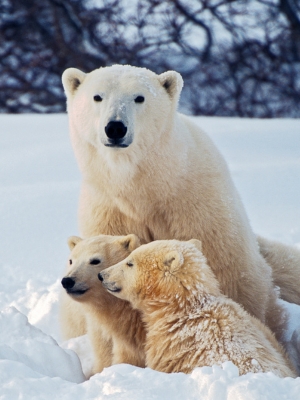I witness amazing, heartwarming scenes at the sanctuary every single day. Here is just one of those stories…
In 2010, we found her wandering aimlessly in the five-acre northwest enclosure, one of 136 monkeys occupying the large natural area. She was moving in an erratic line, taking a few steps at a time and then stopping to extend her hand in front of her, feeling for trees, brush, or monkeys. We could tell that the old girl had gone blind, likely due to age-related issues. After determining there wasn’t any way to repair the damage, we decided to leave her where she was and watch her closely to see if she would adjust. [teaserbreak]
Simon, an adult male snow monkey living in the same enclosure, had gone blind years before, and was getting along well. He’d developed a good mental map of the area, and we simply needed to check on him daily to ensure he could eat his fill in peace. If, at first, I didn’t see him, he would often find me as I made my rounds through the enclosure, following the sounds of my wheelbarrow, having learned that it was loaded with produce and special monkey food. He would amble up and sit in the shade of the cart while I handed him his favorite foods. This was our daily hope for the monkey that intern Rachel Bogan named “Carmelita.”
As the days passed, it became apparent that Carmelita was having trouble transitioning. She appeared to get frustrated frequently and would vocalize her angst when, arms outstretched to avoid running into something, she would tragically push her face into the bush her hands had missed. After a few of these experiences, she moved very slowly, hands and feet on the ground and her face pushed forward in an attempt to see or smell obstacles. Her appetite was good, but it was difficult to approach her, as the sound of our feet made her uncomfortable. She soon learned the sound of food hitting the ground, so we were able to toss her bananas, chow, and apples.
It wasn’t enough, though, and she was losing weight—and her will to keep going. It was time to try something different to help her recover some spirit and have a reasonably good life.
The decision to relocate her to one of the smaller enclosures was a tough one. I had watched the year before as Goldie, another old snow monkey girl who had lived her life substantially free, literally went crazy with anxiety after being caged to treat her and to keep her safe. “For your own good” doesn’t cut it with monkeys who are hard-wired for freedom. Goldie recovered quickly once we put her back out where she wanted to be. Would Carmelita stress out, too? Stop eating?
Fortunately, we had just the companion for her. Under Theo’s gentle and patient watch, Carmelita soon settled into the smaller semi-natural enclosure, next to a few other blind monkeys, where she would climb up the large tree trunks and stretch out on a sky walk. Theo would often groom her and, during feeding time, Carmelita would search through the grass as we tossed her favorite foods to her.
Though they continued to get along fairly well, Theo became interested in Bella. Carmelita was increasingly left to her own devices as Theo worked to impress the next door neighbor. Eventually, Bella and Theo needed to be together. Bella is the jealous type, so we worried that she might injure Carmelita if kept all together.
It was time to move Carmelita, but this move would just be to the other side of the enclosure with Helena and Puma, both also blind.
One morning, a scene unfolded like a poignant movie about love lost and found. Carmelita and Puma ended up face to face on a sky walk, ten feet off the ground. Ancient monkey faces pressed close to each other, smelling and sensing. Suddenly, Carmelita raised her voice in a staccato chatter, becoming agitated and grabbing at Puma with both hands. Puma grunted in a low pitch, and then the two of them were awkwardly hugging, squeezing, and half rolling, Carmelita yelling at Puma, and Puma grunting loudly in excitement. They still do this ritual occasionally, ending with a hug: two thick coats melding into one.
We’ll never know the when or how of it, but these two aged monkeys, both descendants of the original troop of snow monkeys brought over from Arashyama, Japan in 1972, knew each other—and, in blindness, after all these years, had somehow found one another.
For the primates,
Tim
 Dear Reader,
Dear Reader,